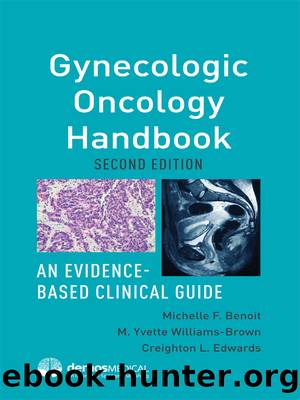Gynecologic Oncology Handbook by Michelle F. Benoit

Author:Michelle F. Benoit
Language: eng
Format: epub
Publisher: Springer Publishing Company
Published: 2017-07-07T00:00:00+00:00
â¢The 2004 HNPCC Bethesda Guidelines were modified to include endometrial cancer as a sentinel cancer. Bethesda Guidelines for Lynch Syndrome (LS): this guides tumor testing for microsatellite instability (MSI) in individuals with the following:
Diagnosed in a patient who is younger than 50 years of age.
Presence of synchronous, or metachronous, colorectal cancer (CRC) or other LS-related tumors, regardless of age.
CRC with IHC deficient MSI histology diagnosed in a patient who is younger than 60 years of age.
CRC diagnosed in a patient with one or more first-degree relatives with an LS-related cancer with one of the cancers being diagnosed before age 50 years.
CRC diagnosed in a patient with two or more first- or second-degree relatives with LS-related cancers regardless of age.
â¢Amsterdam Criteria I: at least three relatives with CRC; all of the following criteria should be present:
One should be a first-degree relative of the other two.
At least two successive generations must be affected.
At least one of the relatives with CRC must have received the diagnosis before the age of 50 years.
Familial adenomatous polyposis (FAP) should be excluded.
Tumors should be verified by pathologic examination.
â¢Amsterdam Criteria II: at least three relatives must have a cancer associated with LS (colorectal, cancer of endometrium, small bowel, ureter, or renal-pelvis); all of the following criteria should be present:
One must be a first-degree relative of the other two.
At least two successive generations must be affected.
At least one relative with cancer associated with LS should be diagnosed before age 50 years.
FAP should be excluded in the CRC case(s) (if any).
Tumors should be pathologically verified whenever possible.
â¢Patients should be screened for Lynch/HNPCC syndrome if:
They have an endometrial or ovarian cancer and have a synchronous or metachronous colon or other Lynch/HNPCC-associated tumors at any age to include: stomach, ovarian, pancreas, ureter, renal pelvis, biliary tract, brain glioblastoma as seen in Turcot syndrome, sebaceous gland adenomas and keratoacanthomas in Muir-Torre syndrome, carcinoma of the small bowel.
Patients with colorectal cancer with tumor infiltrating lymphocytes, peritumoral lymphocytes, Crohn-like lymphocytic reaction, mucinous/signet-ring differentiation, or medullary growth pattern diagnosed before the age of 60.
Patients with endometrial or colorectal cancer and a first-degree relative with a Lynch/HNPCC-associated tumor diagnosed before the age of 50.
Patients with colorectal or endometrial cancer diagnosed at any age with two or more first degree or second degree relatives with Lynch/HNPCC-associated tumors regardless of age.
Download
This site does not store any files on its server. We only index and link to content provided by other sites. Please contact the content providers to delete copyright contents if any and email us, we'll remove relevant links or contents immediately.
| Bone Cancer | Brain Cancer |
| Breast Cancer | Colorectal |
| Leukemia | Lung Cancer |
| Lymphatic | Prostate Disease |
| Skin Cancer |
Men In Love by Nancy Friday(5134)
Everything Happens for a Reason by Kate Bowler(4651)
The Immortal Life of Henrietta Lacks by Rebecca Skloot(4492)
Why We Sleep by Matthew Walker(4337)
The Sports Rules Book by Human Kinetics(4259)
Not a Diet Book by James Smith(3315)
The Emperor of All Maladies: A Biography of Cancer by Siddhartha Mukherjee(3040)
Sapiens and Homo Deus by Yuval Noah Harari(2965)
Day by Elie Wiesel(2702)
Angels in America by Tony Kushner(2513)
A Burst of Light by Audre Lorde(2467)
Endless Forms Most Beautiful by Sean B. Carroll(2410)
Hashimoto's Protocol by Izabella Wentz PharmD(2294)
Dirty Genes by Ben Lynch(2257)
Reservoir 13 by Jon McGregor(2223)
And the Band Played On by Randy Shilts(2109)
Wonder by R J Palacio(2104)
The Immune System Recovery Plan by Susan Blum(2011)
Stretching to Stay Young by Jessica Matthews(1990)
